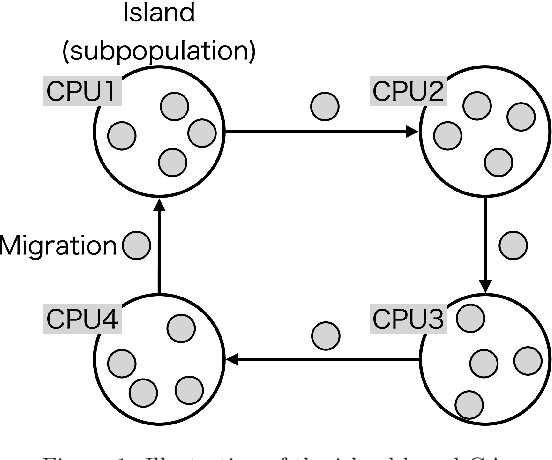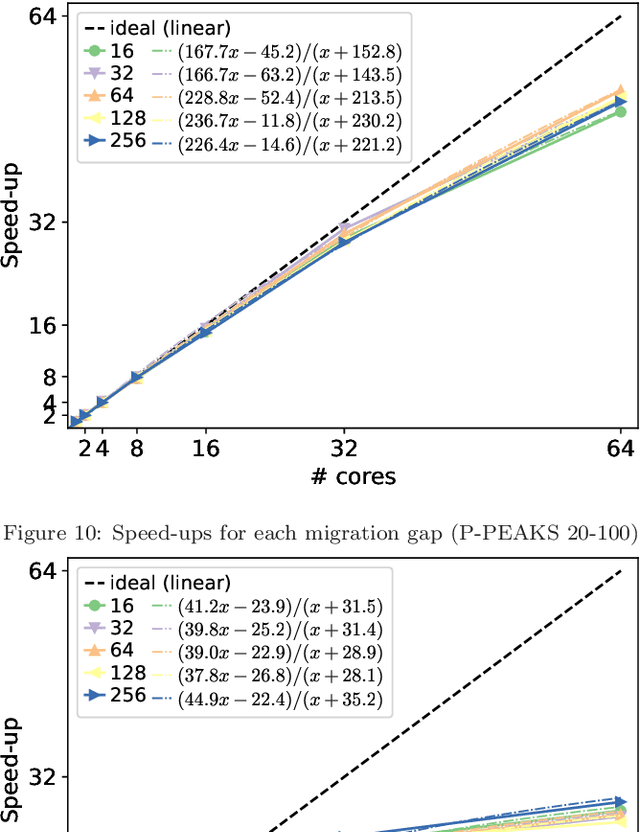Tomohiro Harada
Energy and Quality of Surrogate-Assisted Search Algorithms: a First Analysis
Aug 11, 2025Abstract:Solving complex real problems often demands advanced algorithms, and then continuous improvements in the internal operations of a search technique are needed. Hybrid algorithms, parallel techniques, theoretical advances, and much more are needed to transform a general search algorithm into an efficient, useful one in practice. In this paper, we study how surrogates are helping metaheuristics from an important and understudied point of view: their energy profile. Even if surrogates are a great idea for substituting a time-demanding complex fitness function, the energy profile, general efficiency, and accuracy of the resulting surrogate-assisted metaheuristic still need considerable research. In this work, we make a first step in analyzing particle swarm optimization in different versions (including pre-trained and retrained neural networks as surrogates) for its energy profile (for both processor and memory), plus a further study on the surrogate accuracy to properly drive the search towards an acceptable solution. Our conclusions shed new light on this topic and could be understood as the first step towards a methodology for assessing surrogate-assisted algorithms not only accounting for time or numerical efficiency but also for energy and surrogate accuracy for a better, more holistic characterization of optimization and learning techniques.
* 8 pages, 8 figures, 2024 IEEE Congress on Evolutionary Computation (CEC)
A Frequency-based Parent Selection for Reducing the Effect of Evaluation Time Bias in Asynchronous Parallel Multi-objective Evolutionary Algorithms
Jul 26, 2021



Abstract:This paper proposes a new parent selection method for reducing the effect of evaluation time bias in asynchronous parallel evolutionary algorithms (APEAs). APEAs have the advantage of increasing computational efficiency even when the evaluation times of solutions differ. However, APEAs have a problem that their search direction is biased toward the search region with a short evaluation time. The proposed parent selection method considers the search frequency of solutions to reduce such an adverse influence of APEAs while maintaining their computational efficiency. We conduct experiments on toy problems that reproduce the evaluation time bias on multi-objective optimization problems to investigate the effectiveness of the proposed method. The experiments use NSGA-III, a well-known multi-objective evolutionary algorithm. In the experiments, we compare the proposed method with the synchronous and asynchronous methods. The experimental results reveal that the proposed method can reduce the effect of the evaluation time bias while reducing the computing time of the parallel NSGA-III.
A Fresh Approach to Evaluate Performance in Distributed Parallel Genetic Algorithms
Jun 18, 2021



Abstract:This work proposes a novel approach to evaluate and analyze the behavior of multi-population parallel genetic algorithms (PGAs) when running on a cluster of multi-core processors. In particular, we deeply study their numerical and computational behavior by proposing a mathematical model representing the observed performance curves. In them, we discuss the emerging mathematical descriptions of PGA performance instead of, e.g., individual isolated results subject to visual inspection, for a better understanding of the effects of the number of cores used (scalability), their migration policy (the migration gap, in this paper), and the features of the solved problem (type of encoding and problem size). The conclusions based on the real figures and the numerical models fitting them represent a fresh way of understanding their speed-up, running time, and numerical effort, allowing a comparison based on a few meaningful numeric parameters. This represents a set of conclusions beyond the usual textual lessons found in past works on PGAs. It can be used as an estimation tool for the future performance of the algorithms and a way of finding out their limitations.
Towards An Angry-Birds-like Game System for Promoting Mental Well-being of Players Using Art-Therapy-embedded PCG
Nov 07, 2019

Abstract:This paper presents an integration of a game system and the art therapy concept for promoting the mental well-being of video game players. In the proposed game system, the player plays an Angry-Birds-like game in which levels in the game are generated based on images they draw. Upon finishing a game level, the player also receives positive feedback (praising words) toward their drawing and the generated level from an Art Therapy AI. The proposed system is composed of three major parts: (1) a drawing recognizer that identifies what object is drawn by the player (Sketcher), (2) a level generator that converts the drawing image into a pixel image, then a set of blocks representing a game level (PCG AI), and (3) the Art Therapy AI that encourages the player and improves their emotion. This paper describes an overview of the system and explains how its major components function.
Adaptive Motion Gaming AI for Health Promotion
Apr 04, 2017



Abstract:This paper presents a design of a non-player character (AI) for promoting balancedness in use of body segments when engaging in full-body motion gaming. In our experiment, we settle a battle between the proposed AI and a player by using FightingICE, a fighting game platform for AI development. A middleware called UKI is used to allow the player to control the game by using body motion instead of the keyboard and mouse. During gameplay, the proposed AI analyze health states of the player; it determines its next action by predicting how each candidate action, recommended by a Monte-Carlo tree search algorithm, will induce the player to move, and how the player's health tends to be affected. Our result demonstrates successful improvement in balancedness in use of body segments on 4 out of 5 subjects.
Procedural Generation of Angry Birds Levels using Building Constructive Grammar with Chinese-Style and/or Japanese-Style Models
Apr 27, 2016


Abstract:This paper presents a procedural generation method that creates visually attractive levels for the Angry Birds game. Besides being an immensely popular mobile game, Angry Birds has recently become a test bed for various artificial intelligence technologies. We propose a new approach for procedurally generating Angry Birds levels using Chinese style and Japanese style building structures. A conducted experiment confirms the effectiveness of our approach with statistical significance.
 Add to Chrome
Add to Chrome Add to Firefox
Add to Firefox Add to Edge
Add to Edge